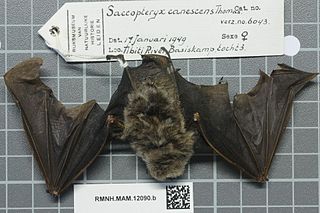
The frosted sac-winged bat is a bat species of the family Emballonuridae from South America. It is found in northern Brazil, Colombia, Ecuador, French Guiana, Guyana, Peru, Surinam, Venezuela and possibly Bolivia.
The dusky catshark is a catshark of the family Scyliorhinidae that is endemic to the southeast Pacific Ocean, off the coasts of Peru and Chile. It grows to a maximum length of 70 cm, and is oviparous like many other chondrichthyans in the Indo-Pacific.
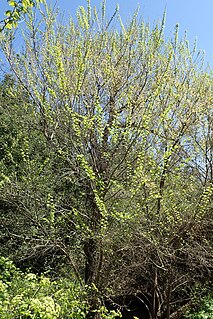
Ulmus canescens is a small deciduous tree occasionally known by the common names grey elm, grey-leafed elm, and hoary elm. Its natural range extends through the lands of the central and eastern Mediterranean, from southern Italy, the islands of Sicily, Malta, Crete, Rhodes and Cyprus, to Turkey, and as far south as Israel, where it is now considered rare and endangered in the wild. The tree is typically found amidst the comparatively humid coastal woodlands and scrublands.
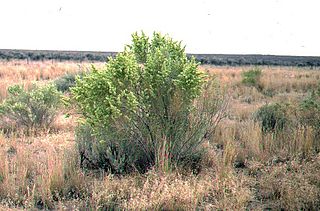
Atriplex canescens, chamiso, chamiza, four wing saltbush, four-wing saltbush, and fourwing saltbush, is a species of evergreen shrub in the family Amaranthaceae native to the western and midwestern United States.
Callitris canescens is a species of conifer in the family Cupressaceae. It is found only in Australia.
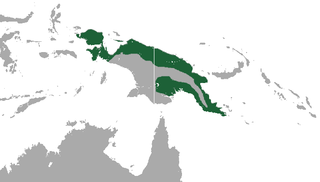
The lowland ringtail possum is a species of marsupial in the family Pseudocheiridae. It's found in Indonesia, the Solomon Islands, and Papua New Guinea.

Geraea canescens, commonly known as desert sunflower, hairy desert sunflower, or desert gold, is an annual plant in the family Asteraceae. "Geraea" in its scientific name comes from the Greek geraios, referring to the white hairs on the fruits.
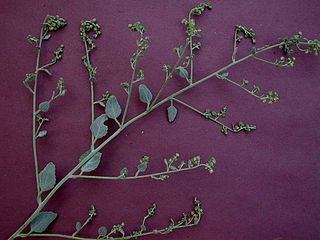
Dicoria canescens is a North American flowering plant in the daisy family known by several common names including desert twinbugs and bugseed. This is a desert plant of the southwestern United States and northwestern Mexico, found in Sonora, Baja California, southern California, Nevada, Arizona, Utah, southwestern Colorado, and northwestern New Mexico.

Calamagrostis canescens, known as purple small-reed, is a species of grass in the family Poaceae, native to Europe and western Siberia.
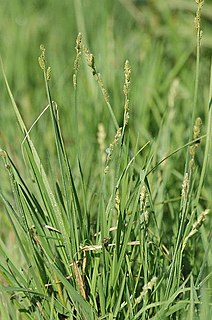
Carex canescens L. is a perennial species of plants in the family Cyperaceae growing in damp forests and wetlands. It is widespread across much of Europe, Asia, Australia, New Guinea, North America, and southern South America.
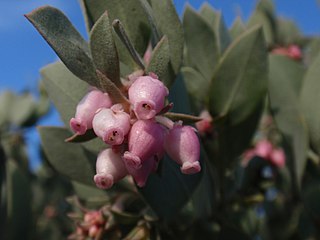
Arctostaphylos canescens, common name hoary manzanita, is a species of manzanita.

Dieteria canascens is an annual plant or short lived perennial plant in the, known by the common names hoary tansyaster and hoary-aster.
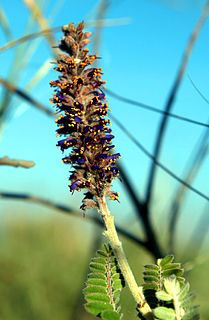
Amorpha canescens, known as leadplant, downy indigo bush, prairie shoestring, or buffalo bellows, is a small, perennial semi-shrub in the pea family (Fabaceae), native to North America. It has very small purple flowers with yellow stamens which are grouped in racemes. Depending on location, the flowers bloom from late June through mid-September. The compound leaves of this plant appear leaden due to their dense hairiness. The roots can grow up to 5 m (16 ft) deep and can spread up to 1 metre radially. This plant can be found growing in well-drained soils of prairies, bluffs, and open woodlands.
Eutrichillus is a genus of longhorn beetles of the subfamily Lamiinae. It was described by Bates in 1885.
Eutrichillus biguttatus is a species of longhorn beetle of the subfamily Lamiinae. It was described by John Lawrence LeConte in 1852.
Eutrichillus neomexicanus is a species of longhorn beetles of the subfamily Lamiinae. It was described by Champlain and Knull in 1925.
Eutrichillus pini is a species of longhorn beetles of the subfamily Lamiinae. It was described by Schaeffer in 1905.
Eutrichillus brevipilus is a species of longhorn beetles of the subfamily Lamiinae. It was described by Chemsak and Linsley in 1986, and is known from northwestern Mexico.

Populus × canescens, the grey poplar, is a hybrid between Populus alba and Populus tremula. It is intermediate between its parents, with a thin grey downy coating on the leaves, which are also much less deeply lobed than the leaves of P. albus. It is a very vigorous tree with marked hybrid vigour, reaching 40 m tall and with a trunk diameter over 1.5 m – much larger than either of its parents. Most trees in cultivation are male, but female trees occur naturally and some of these are also propagated.
The Field Elm cultivar Ulmus minor 'Cretensis' [:from Crete] was first mentioned by Nicholson in Kew Hand-List Trees & Shrubs Vol.2 (1896), as Ulmus campestris var. cretensis, without description. A 1908 herbarium specimen at Kew Gardens with an accompanying description suggests that 'Cretensis' is not synonymous with Ulmus minor var. canescens, also present on Crete.













